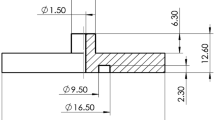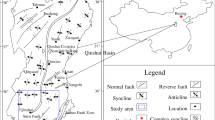Abstract
Based on injection pressure drop test data and acoustic emission test data of 13 records for samples from the Wenjiazhuang and Sijiazhuang mines in the Yangquan mining area, the vertical distribution characteristics of modern in situ stress and its influence on permeability in the Yangquan mining area were analyzed, and the exploitation of the No. 15 coal reservoir was studied. The results show that the Yangquan mining area is a low-stress area within burial depths of 400–760 m, moderate-stress area within 760–950 m, and high-stress area within 950–1300 m. The Yangquan mining area hosts a strike–slip fault stress field within burial depths of 400–900 m and a normal fault stress field within burial depths of 900–1300 m, and the permeability showed a “decrease–increase–decrease” trend with an increase in burial depth. The pressure coefficient K of the modern in situ stress field in the Yangquan mining area decreased with increasing burial depth, and its relationship formula with burial depth was 68.25/H + 0.2846 ≤ K ≤ 397.63/H + 0.6061. The permeability of No. 15 coal seam had a strong logarithmic relationship with horizontal principal stress, a strong exponential relationship with horizontal principal stress difference, and a strong power function relationship with effective stress. With an increase in stress and in stress difference, permeability decreased rapidly. The results of the acoustic emission tests of the No. 15 coal were analyzed. The in situ stress type of the Sijiazhuang mine and Wenjiazhuang mine is the normal fault stress field type, which is consistent with the well test analysis results. The high ring counts in the horizontal direction of coal seam 15 lasted for a long time, which was conducive to the generation of several network-forming fractures in the process of fracturing. The No. 15 coal reservoir is located in strike–slip fault stress field and normal fault stress field areas, and the fractures generated by hydraulic fracturing expanded along the vertical direction and the maximum horizontal principal stress direction, which was favorable for the fracturing transformation of coal reservoirs and the production and development of coalbed methane.










Similar content being viewed by others
References
Aminian, K., & Ameri, S. (2009). Predicting production performance of CBM reservoirs. Journal of Natural Gas Science and Engineering, 1(1–2), 25–30.
Anderson, E. M. (1951). The dynamics of faulting and Dyke formation with application to Britain (2nd ed.). Oliver & Boyd.
Bao, H. Z., S, L. H., Yu, L. L., & Zhang, H. W. (2009). Determination of in-situ stress by Kaiser effect of rock acoustic emission. Fault block oil and gas field, 16(06), 94–96.
Brown, E. T., & Hoek, E. (1978). Trends in relationships between measured in-situ, stresses and depth. International Journal of Rock Mechanics & Mining Sciences & Geomechanics Abstracts, 15(4), 211–215.
Cai, M. F., Qiao, L., & Li, H. B. (1995). Principle and technology of in-situ stress measurement (pp. 38–40). Science Press.
Cao, L., T. (2020). Comprehensive evaluation of coal reservoir removability based on seismic geology. China University of Geosciences.
Che, C. B., Yang, H. L., Li, F. B., Liu, C. L., Zhu, J., Li, Y. X., & Tang, W. L. (2008). Exploration and development prospects of coal bed methane (CBM) resources in China. China Mining Magazine, 17(5), 1–4.
Chen, S., Tang, D., Tao, S., Xu, H., Li, S., Zhao, J., Cui, Y., & Li, Z. (2018). Characteristics of in-situ stress distribution and its significance on the coalbed methane (CBM) development in Fanzhuang-Zhengzhuang Block, Southern Qinshui Basin China. Journal of Petroleum Science and Engineering, 161, 108–120.
Chen, S., Tang, D., Tao, S., Xu, H., Li, S., Zhao, J., Ren, P., & Fu, H. (2017). In-situ stress measurements and stress distribution characteristics of coal reservoirs in major coalfields in China, Implication for coalbed methane (CBM) development. International Journal of Coal Geology, 182, 66–84.
Chen, Y., Liu, D., Yao, Y., Cai, Y., & Chen, L. (2015). Dynamic permeability change during coalbed methane production and its controlling factors. Journal of Natural Gas Science and Engineering, 25, 335–346.
Flores, R. M. (1998). Coalbed methane, from hazard to resource. International Journal of Coal Geology, 35(1–4), 3–26.
Ge, B. X., Yin, G. X., & Li, C. S. (1985). Discussion on sedimentary environment and coal accumulation law of coal bearing strata in Yangquan mining area, Shanxi Province. Acta Sedimentology, 03, 33–44.
Hu, Q., Wang, S. W., Zhang, C., et al. (2014). Influence of coal body structure on coalbed methane development in Qinnan area. Coal Science and Technology, 8, 95–68.
Jiao, X. Y., & Wang, Y. (1999). Sedimentary environment of coal bearing strata in Yangquan mining area and its control on coal seam thickness distribution. Lithofacies Paleogeography, 19(03), 30–39.
Ju, W., Shen, J., Qin, Y., Meng, S., Li, C., Li, G., & Yang, G. (2018). In-situ stress distribution and coalbed methane reservoir permeability in the Linxing area, eastern Ordos Basin, China. Frontiers of Earth Science, 12(3), 545–554.
Kang, H. P., Jiang, T. M., Zhang, X., et al. (2009). Study and application of in-situ stress field in Jincheng Mining Area. Journal of Rock Mechanics and Engineering, 28(1), 1–8.
Kang, H. P., Zhang, X., Si, L. P., Wu, Y., & Gao, F. (2010). In-situ stress measurements and stress distribution characteristics in underground coal mines in China. Engineering Geology, 116(3–4), 333–345.
Li, C. (2015). Discussion on the relationship between collapse column distribution characteristics and folds, faults and earthquakes in Yangquan mining area. Taiyuan University of technology.
Liu, S. M., & Harpalani, S. (2013). Permeability prediction of coalbed methane reservoirs during primary depletion. International Journal of Coal Geology, 113, 1–10.
Lou, Y., Zhang, G. Q., & Wang, X. X. (2017). Study on fracture mechanism of hydraulic fracturing in sandstone by acoustic emission parameters. Procedia Engineering, 191, 291–298.
Meng, Z. P., & Liu, S. M. (2018). Geology and engineering of coalbed methane development in coal mining area (pp. 203–213). Science Press.
Meng, Z. P., Zhang, J., & Wang, R. (2011). In-situ stress, pore pressure and stress-dependent permeability in the Southern Qinshui Basin. International Journal of Rock Mechanics & Mining Sciences, 48(1), 122–131.
Shao, X. J., Dong, X. X., Tang, D. Z., et al. (2014). Dynamic variation of permeability and its influence on productivity in the process of CBM development. Acta Coal Sinica, 39(S1), 146–151.
Shi, J. Q., Pan, Z. J., & Sevket, D. (2014). Analytical models for coal permeability changes during coalbed methane recovery, model comparison and performance evaluation. International Journal of Coal Geology, 136, 17–24.
Shu, T., Yanbin, W., Dazhen, T., Hao, X., Yumin, L., Wei, H., & Yong, L. (2012). Dynamic variation effects of coal permeability during the coalbed methane development process in the Qinshui Basin. China. International Journal of Coal Geology, 93(4), 16–22.
Tang, D. Z., Liu, D. M., Tang, S. H., et al. (2014). Dynamic geological effect of reservoir during CBM development. Science Press.
Tang, S., Tang, D., Li, S., Xu, H., Tao, S., Geng, Y., Ma, L., & Zhu, X. (2017). Fracture system identification of coal reservoir and the productivity differences of CBM wells with different coal structures, a case in the Yanchuannan block, Ordos Basin. Journal of Petroleum Science and Engineering, 161, 175–189.
Teng, J., Yao, Y., Liu, M., et al. (2015). Evaluation of coal texture distributions in the southern Qinshui basin, North China, Investigation by a multiple geophysical logging method. International Journal of Coal Geology, 140, 9–22.
Wang, J. L., Qin, Y., & Fu, X. H. (2012). Dynamic variation law of coal reservoir permeability under multi factor superposition. Acta Coal Sinica, 37(08), 1348–1353.
Wang, Q. C., Jin, G. H., & Wang, Q. (2017). Analysis of the influence of coal body structure on fracturing. China Coalbed Methane, 14(5), 8–10.
Xu, H., Tang, D. Z., Tang, S. H., Zhao, J. L., Meng, Y. J., & Tao, S. (2014). A dynamic prediction model for gas-water effective permeability based on coalbed methane production data. International Journal of Coal Geology, 121, 44–52.
Yang, Z. B., & Qin, Y. (2015). Study on adjustment of multilayer superimposed independent gas bearing system under in-situ stress. Journal of China University of Mining and Technology, 44(01), 70–75.
Zhang, P., Meng, Z., Zhang, K., & Jiang, S. (2020). Impact of coal ranks and confining pressures on coal strength, permeability, and acoustic emission. International Journal of Geomechanics, 20(8), 04020135.
Zhang, X., Ranjith, P. G., Lu, Y., & Ranathunga, A. S. (2019). Experimental investigation of the influence of CO2 and water adsorption on mechanics of coal under confining pressure. International Journal of Coal Geology, 209, 117–129.
Zhao, J., P., Zhang, Y., Q., Zhang, S., et al. (2017). Influence of coal body structure on CBM well productivity and countermeasures. China CBM, 14(2), 9–12.
Zhao, J., Tang, D., Xu, H., Li, Y., Li, S., Tao, S., Lin, W., & Liu, Z. (2016). Characteristic of in situ stress and its control on the coalbed methane reservoir permeability in the eastern margin of the Ordos Basin China. Rock Mechanics and Rock Engineering, 49(8), 3307–3322.
Zoback, M. D., Barton, C. A., Brudy, M., Castillo, D. A., Finkbeiner, T., Grollimund, B. R., & Wiprut, D. J. (2003). Determination of stress orientation and magnitude in deep wells. International Journal of Rock Mechanics and Mining Sciences, 40(7–8), 1049–1076.
Acknowledgments
This work was financially supported by the Major National Science and Technology Projects (Number: 2016ZX05067001) and Shanxi Province’s Major Special Science and Technology Project (Number: 20201102001).
Author information
Authors and Affiliations
Corresponding author
Rights and permissions
About this article
Cite this article
Cao, T., Yang, Z., Qin, Y. et al. Characteristics of Modern Geostress and Removability of No. 15 Coal Reservoir, Yangquan Mining Area, China. Nat Resour Res 30, 2211–2223 (2021). https://doi.org/10.1007/s11053-021-09857-x
Received:
Accepted:
Published:
Issue Date:
DOI: https://doi.org/10.1007/s11053-021-09857-x




